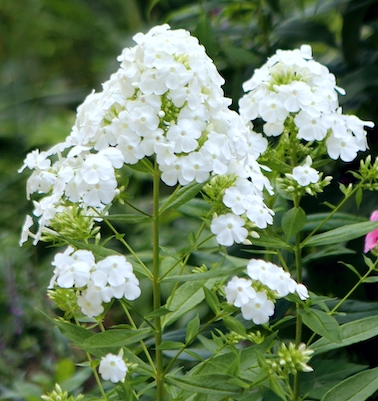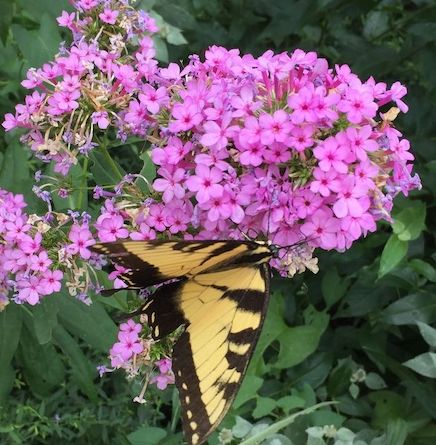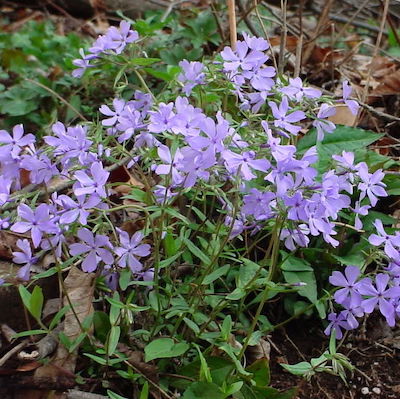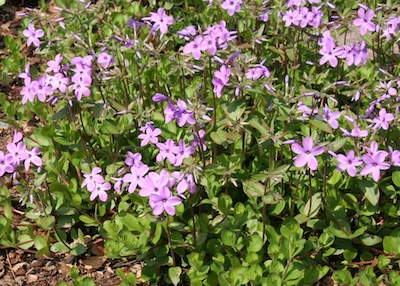Flummoxed by Phlox
by Ray Novitske, Fairfax Master Gardener

Garden Phlox
I planted ‘Miss Lingard’ in the side garden near the path to the backyard. As a white phlox perennial, she grew well for almost a decade and then passed a few years ago after contracting a bad case of powdery mildew. That year, the disease also completely wiped out the woodland phlox in my backyard, but that one is coming back this year!
My sun-loving ‘Miss Lingard’ was a phlox. Those ground cover carpets of pink and lavender that we see around town in spring are phlox. The low height, light shade woodland phlox with its blue flowers is also a member of the family. Let’s separate these phlox types out and eliminate any confusion.

Garden phlox ‘Jeana’
Garden phlox (Phlox paniculata), also called fall phlox, summer phlox and tall phlox, grows about 3 to 4 feet tall (1 to 1.2 m). The fragrant flowers are what attracted me to the summer-blooming perennial, especially because they release most of their sweet scent in early evening. They need full sun to part shade, and love fertile, well-drained soils. The clusters of flowers are frequently pink, lavender, white or magenta depending on the cultivar, with the red colors known for attracting hummingbirds. Some recently-introduced cultivars feature variegated colors.
The biggest threat to these phlox is powdery mildew. Minimize the problem by providing good air circulation and avoiding overhead watering. The white-blooming cultivar ‘David’ is known to resist powdery mildew better than others, with newer cultivars now also providing some protection. A few more popular cultivars include ‘Franz Schubert,’ ‘Bright Eyes’ and ‘Lord Clayton.’ I have a new cultivar, ‘Jeana,’ which I have found to be very tough. It blooms in late summer with smaller flowers in the clusters atop 30-inch high (75 cm) stems.

Woodland phlox
I picked up my woodland phlox at a plant sale, after it shouted to me that it was an eastern woodland native. True, Phlox divaricata is a native, but there are also cultivars in the market, and I really don’t know what type my woodland phlox is. As stated, it succumbed to powdery mildew one year and disappeared along with my garden phlox. (It must have been a cool damp spring that year.) I thought I saw a few leaves appear last summer and gave it a lot of attention and care, but I was unsure if I was encouraging the woodland phlox that disappeared or a weed. It began to rise from the dead this spring. A small clump has reappeared along with the slightly fragrant blue flowers to bring some happiness to my light shade garden once again.
This spring blooming perennial prefers shaded or lightly dappled shade and is often found growing around stream banks in the eastern U.S. Woodland phlox spreads slowly from underground runners which produce flowers the following year. The five-petal blue flowers are similar to those of the garden phlox but are not as tightly packed into a solid cluster. They grow shorter, into a 12 to 15 inch (30 to 40 cm) high loose mound that acts like a ground cover the remainder of the year when not blooming. Popular cultivars include ‘Blue Moon,’ ‘Clouds of Perfume’ and ‘Fuller’s White.’

Phlox stolonifera
Creeping phlox (Phlox stolonifera) blooms in mid-spring by forming dense carpets of flowers on plants only 6 to 8 inches high (15 to 20 cm). This phlox is native to the Appalachian mountains and prefers full sun to part shade with moist, slightly acidic soils. As its botanical name implies, it spreads by underground stolons. The hardy native is drought tolerant and is a good candidate for rock gardens and sloping areas, producing covers of flowers in pinks, whites and lavenders.
Moss phlox (Phlox subulata) is sometimes confused with creeping phlox since both are low growing and produce similar colors covering the ground. The moss phlox foliage forms dense moss-like cushions of green after blooming and is very drought-tolerant. The profusion of flowers carpets the plant in spring — flowers like most phlox that contain five petals held above the low growing foliage.

Moss phlox, Phlox subulata
Moss phlox is a native found in sandy areas and prefers moist, humus soils and clear openings in full sun on hot humid days. But, it sometimes dries out without sufficient water and disappears in the heat of summer only to pleasantly return and bloom again next spring. The older portions of a plant may thin out while the perimeter section containing new growth becomes more vigorous. The good news with moss phlox is that it is resistant to powdery mildew, unlike the other phlox species, and is not very appetizing to deer.
If considering a native flowering perennial for your garden, consider an often-overlooked phlox. The newer cultivars, although not true natives, offer some protection against the dreaded powdery mildew that phlox are known for getting. With the different species and new cultivars, you can find a phlox suitable for any type of environment and condition.
References
Phlox paniculata, North Carolina Cooperative Extension
Tall Garden Phlox, University of Minnesota Extension
Woodland Phlox, Phlox divaricata, Wisconsin Horticulture, University of Wisconsin-Madison
Phlox stolonifera, Missouri Botanical Garden
About Moss Phlox, University of Maryland Extension
Phlox, Clemson Cooperative Extension Home & Garden Information Center